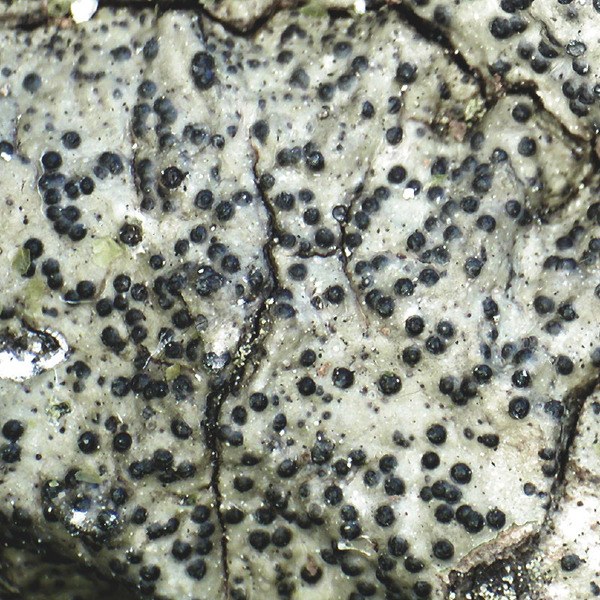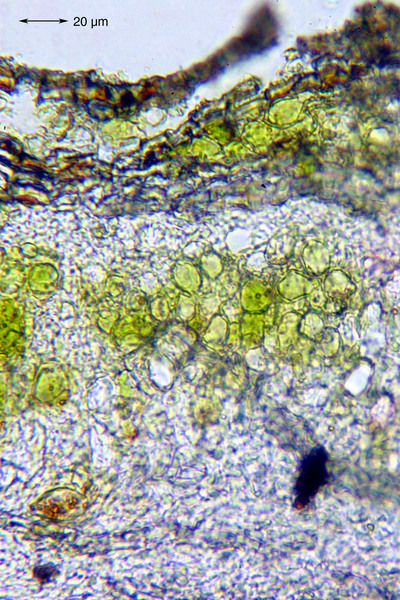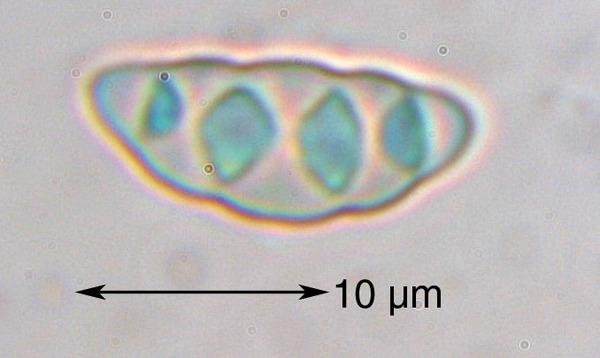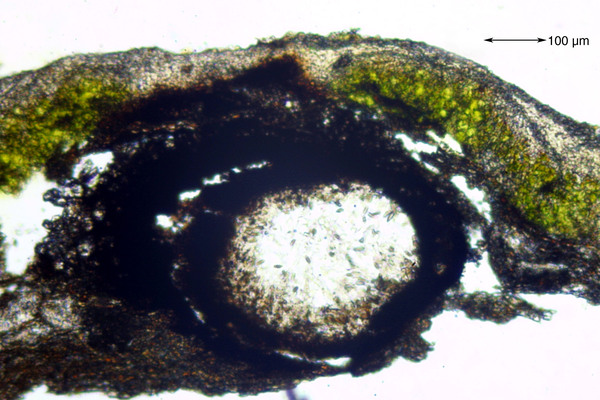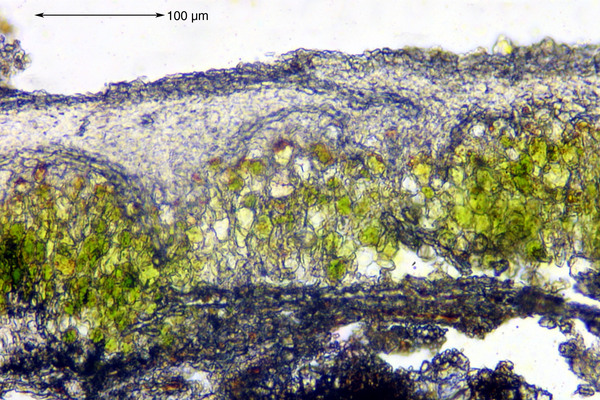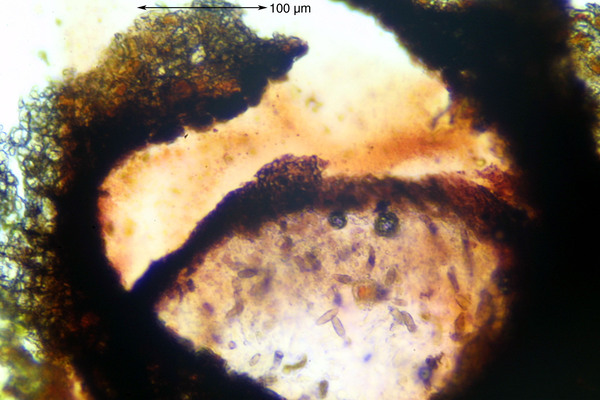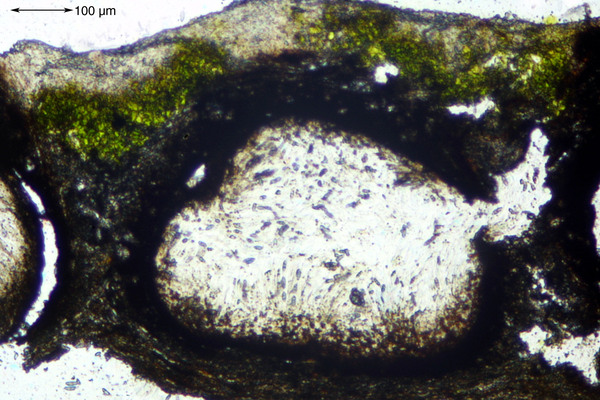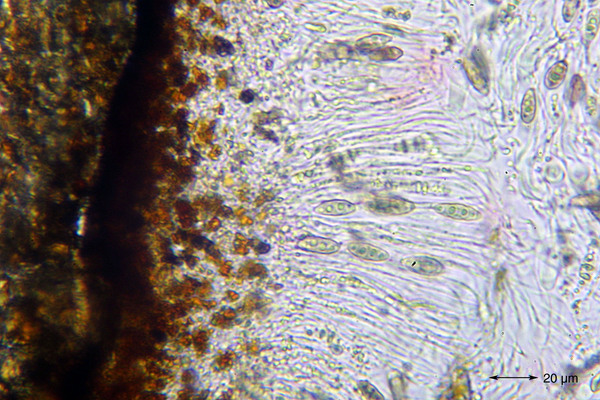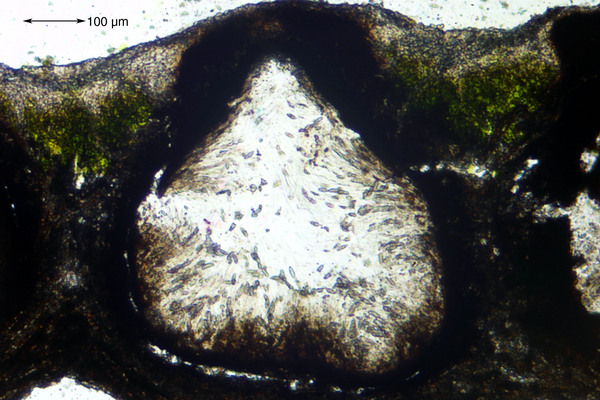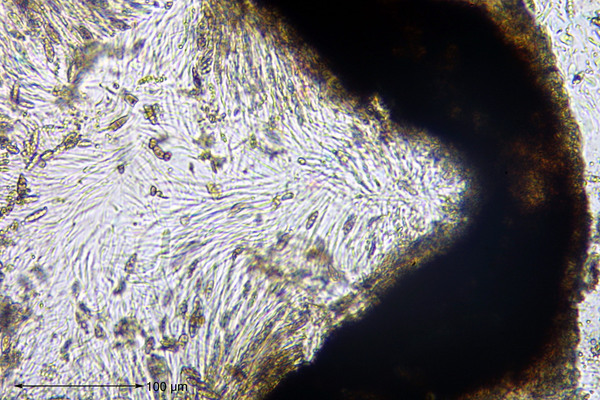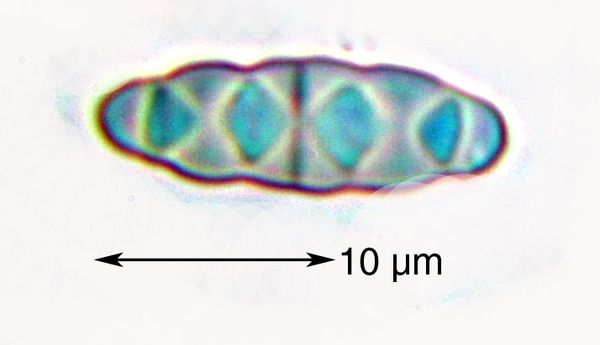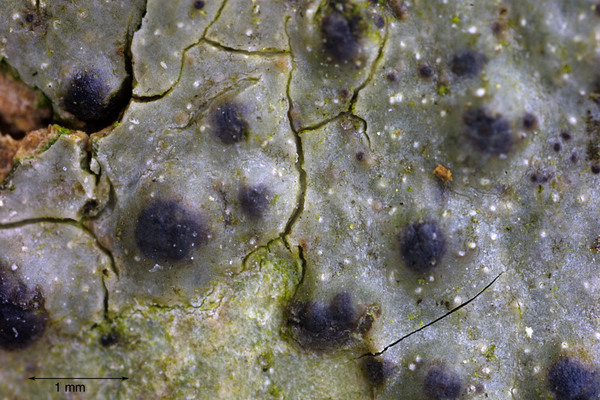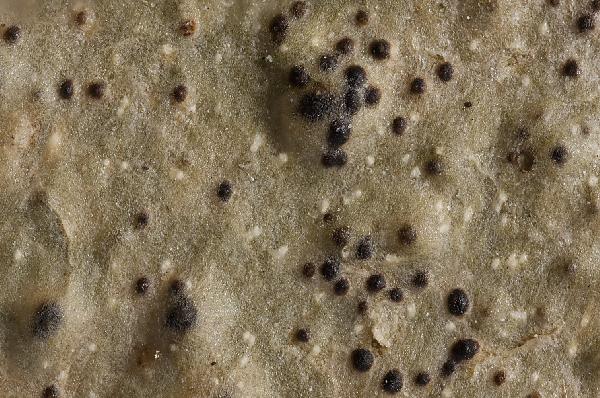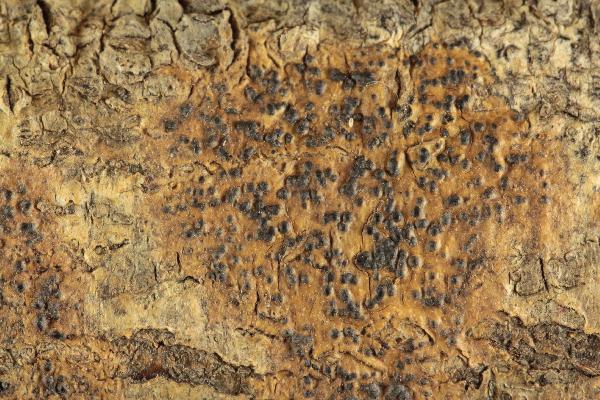Pyrenula nitidella (Schaer.) Müll. Arg.
in Engler, Bot. Jahrb., 6: 414, 1885. Basionym: Verrucaria nitida var. nitidella Flörke ex Schaer. - Lich. Helv. Spicil., 2: 58, 1826.
Synonyms: Bunodea nitida var. nitidella (Schaer.) Beltr.; Pyrenula nitida var. dermatodes (Borrer) Trevis.; Pyrenula nitida var. nitidella (Schaer.) Schaer.
Description: Thallus crustose, more or less immersed in the bark, continuous, smooth, olive-brown to pale brown, often with scattered, whitish, punctiform pseudocyphellae. Perithecia black, 0.2-0.35 mm across, numerous, hemispherical to broadly conical, morly immered in the thallus or forming very low projections. Involucrellum closely adhering to the exciple, which appears dark brown throughout, with colourless crystals of calcium oxalates that are insoluble in K; hymenium colourless, not inspersed with oil droplets, the part adjacent to exciple with brown-orange crystals of anthraquinones reacting K+ red (releasing a red solution); hamathecium of branched and anastomosed periphysoids, later substituted by more or less unbranched paraphyses; ostiole with periphyses. Asci 8-spored, narrowly cylindrical, long-stalked, bitunicate, with tholus, thickened at apex with an internal apical beak, non-amyloid. Ascospores 3-septate, brown, thick-walled, narrowly ellipsoid, with diamond-shaped locules, (20-)22-26(-28) x (8-)8.5-11(-12) μm. Photobiont trentepohlioid. Spot tests: thallus: K- or K+ yellow to red-orange around the perithecia, C-, KC-, P-, UV-. Chemistry: anthraquinones in perithecia and sometimes in thallus.
Growth form: Crustose
Substrata: bark
Photobiont: Trentepohlia
Reproductive strategy: mainly sexual
Most common in areas with a humid-warm climate (e.g. most of Tyrrenian Italy)
Commonnes-rarity: (info)
Alpine belt: absent
Subalpine belt: absent
Montane belt: absent
Dry submediterranean belt: extremely rare
Humid submediterranean belt: rare
Padanian area: absent
pH of the substrata:
1 2 3 4 5
Solar irradiation:
1 2 3 4 5
Aridity:
1 2 3 4 5
Eutrophication:
1 2 3 4 5
Poleotolerance:
0 1 2 3
Altitudinal distribution:
1 2 3 4 5 6
Rarity
absent
extremely rare
very rare
rare
rather rare
rather common
common
very common
extremely common
Loading data...
Occurrence data
Predictive map
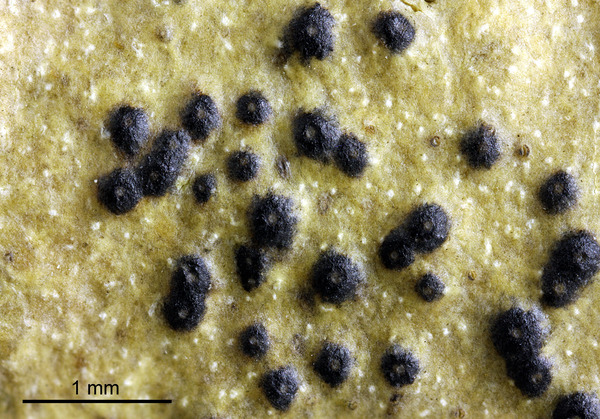
Felix Schumm - CC BY-SA 4.0
[4223], Germany, Baden-Württemberg, Kreis Schwäbisch Gmünd, im Beutenbachtal bei der Beutenmühle ca. 3 km südöstlich von Lorch, ca 310 m, an Fraxinus, TK 7224. Leg. et det. Schumm 29.05.1995
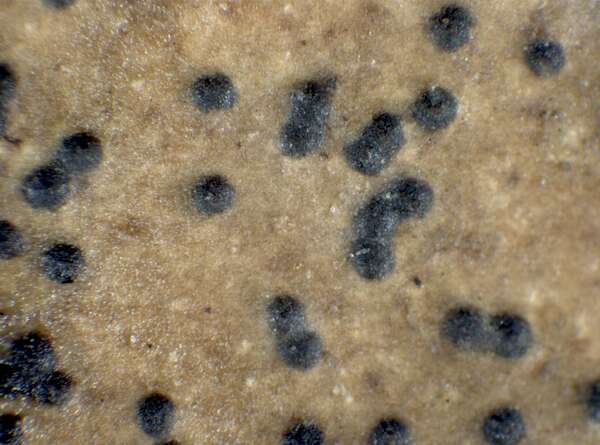
P.L. Nimis; Owner: Department of Life Sciences, University of Trieste
Herbarium: TSB (4184)
2001/11/29
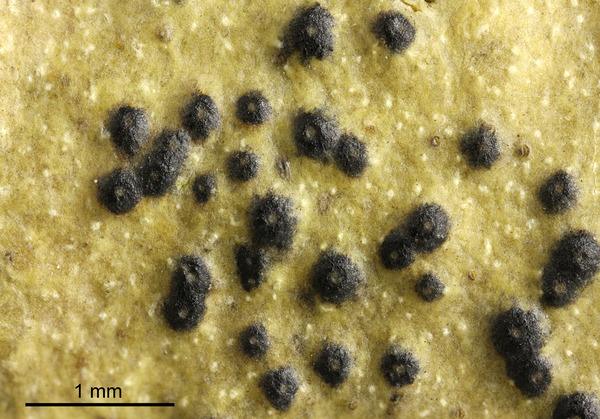
Felix Schumm - CC BY-SA 4.0
[4223], Germany, Baden-Württemberg, Kreis Schwäbisch Gmünd, im Beutenbachtal bei der Beutenmühle ca. 3 km südöstlich von Lorch, ca 310 m, an Fraxinus, TK 7224. Leg. et det. Schumm 29.05.1995
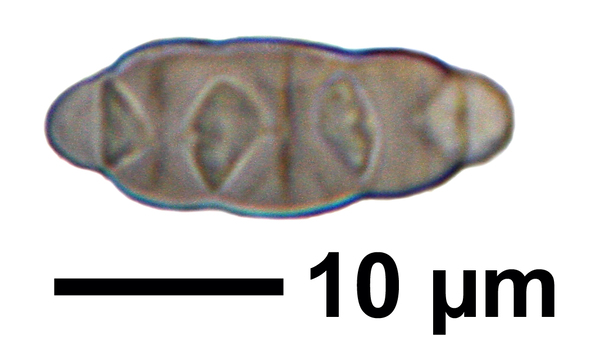
Felix Schumm - CC BY-SA 4.0
[4223], Germany, Baden-Württemberg, Kreis Schwäbisch Gmünd, im Beutenbachtal bei der Beutenmühle ca. 3 km südöstlich von Lorch, ca 310 m, an Fraxinus, TK 7224. Leg. et det. Schumm 29.05.1995
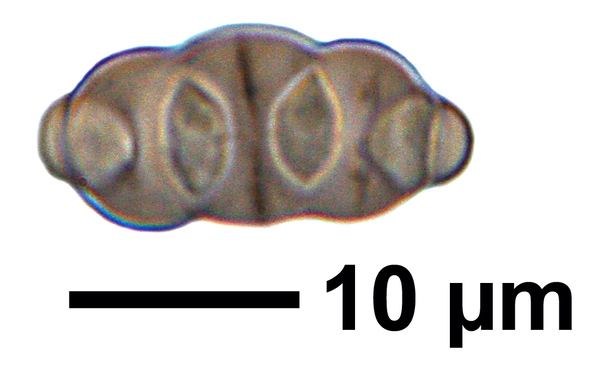
Felix Schumm - CC BY-SA 4.0
[4223], Germany, Baden-Württemberg, Kreis Schwäbisch Gmünd, im Beutenbachtal bei der Beutenmühle ca. 3 km südöstlich von Lorch, ca 310 m, an Fraxinus, TK 7224. Leg. et det. Schumm 29.05.1995
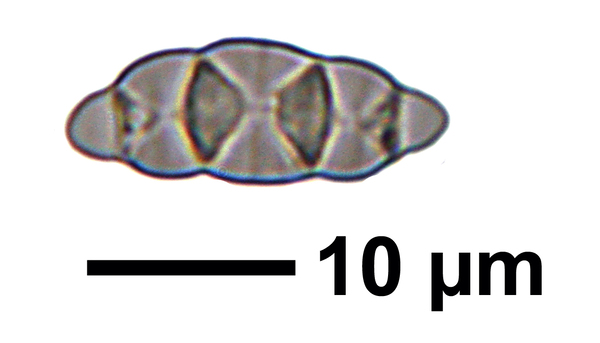
Felix Schumm - CC BY-SA 4.0
[4223], Germany, Baden-Württemberg, Kreis Schwäbisch Gmünd, im Beutenbachtal bei der Beutenmühle ca. 3 km südöstlich von Lorch, ca 310 m, an Fraxinus, TK 7224. Leg. et det. Schumm 29.05.1995
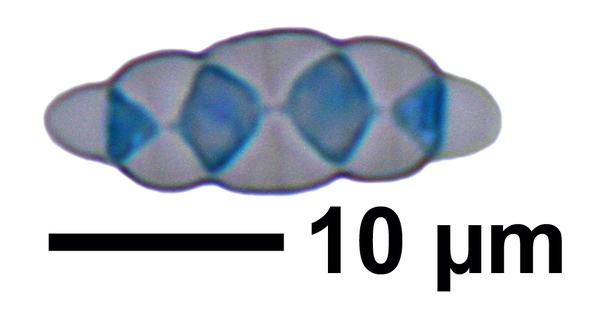
Felix Schumm - CC BY-SA 4.0
[4223], Germany, Baden-Württemberg, Kreis Schwäbisch Gmünd, im Beutenbachtal bei der Beutenmühle ca. 3 km südöstlich von Lorch, ca 310 m, an Fraxinus, TK 7224. Leg. et det. Schumm 29.05.1995
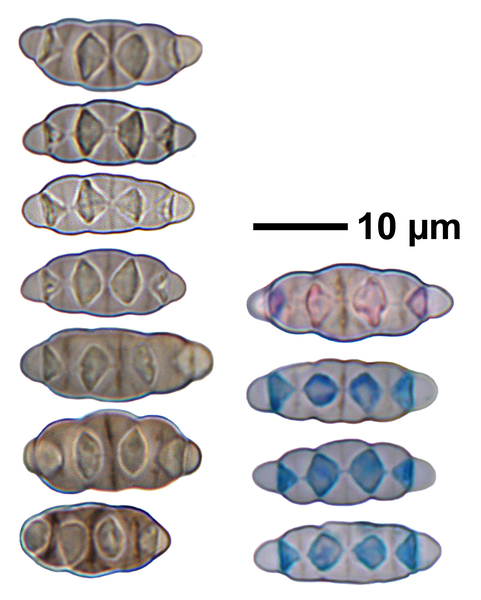
Felix Schumm - CC BY-SA 4.0
[4223], Germany, Baden-Württemberg, Kreis Schwäbisch Gmünd, im Beutenbachtal bei der Beutenmühle ca. 3 km südöstlich von Lorch, ca 310 m, an Fraxinus, TK 7224. Leg. et det. Schumm 29.05.1995
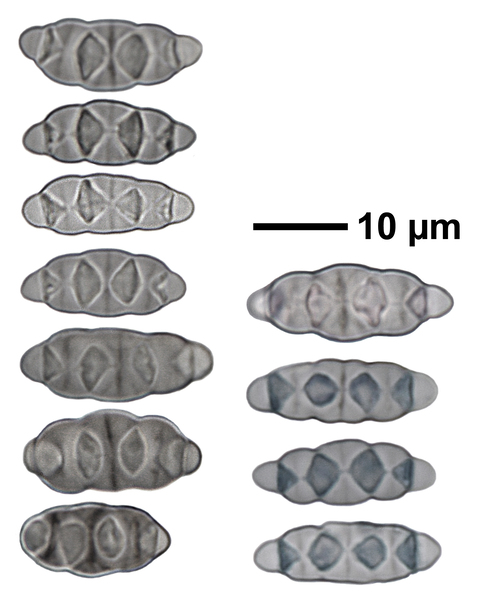
Felix Schumm - CC BY-SA 4.0
[4223], Germany, Baden-Württemberg, Kreis Schwäbisch Gmünd, im Beutenbachtal bei der Beutenmühle ca. 3 km südöstlich von Lorch, ca 310 m, an Fraxinus, TK 7224. Leg. et det. Schumm 29.05.1995
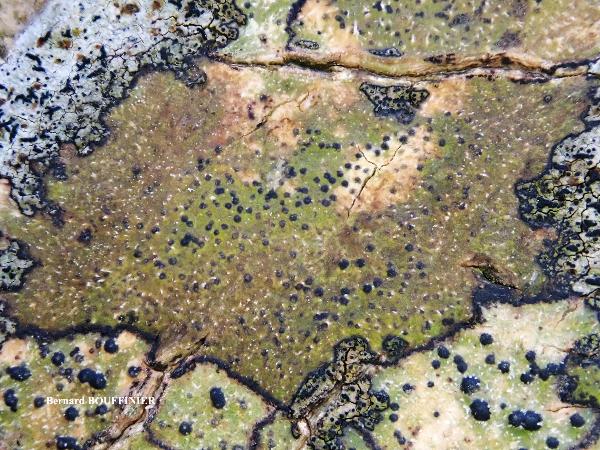
Bernard Bouffinier - Source: http://www.lichensmaritimes.org/index.php?task=fiche&lichen=1055&lang=en
France, Crozon
with P. chlorospila

Bernard Bouffinier - Source: http://www.lichensmaritimes.org/index.php?task=fiche&lichen=1055&lang=en
France, Crozon
with P. chlorospila, which reacts UV+ white

Bernard Bouffinier - Source: http://www.lichensmaritimes.org/index.php?task=fiche&lichen=1055&lang=en
France, Crozon
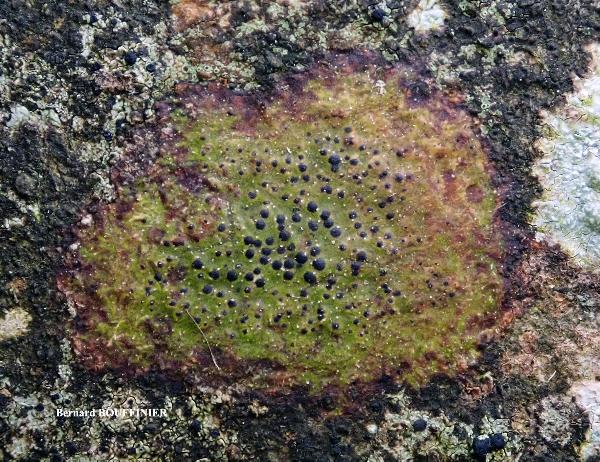
Bernard Bouffinier - Source: http://www.lichensmaritimes.org/index.php?task=fiche&lichen=1055&lang=en
France, Crozon
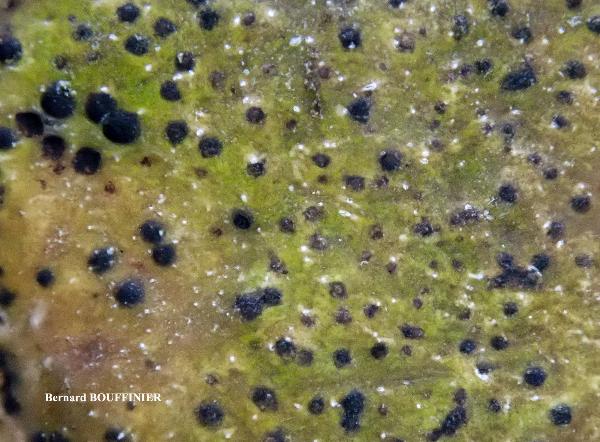
Bernard Bouffinier - Source: http://www.lichensmaritimes.org/index.php?task=fiche&lichen=1055&lang=en
France, Crozon
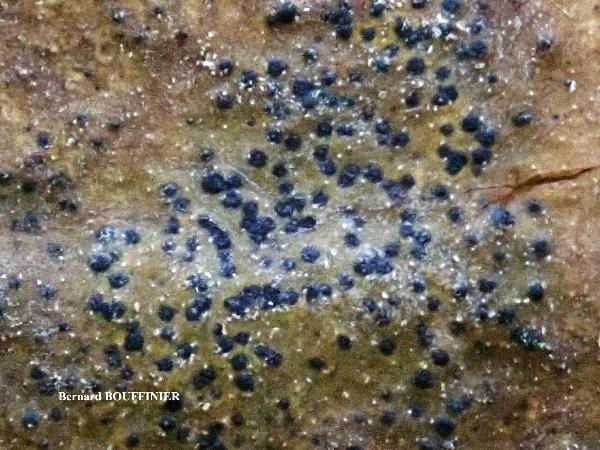
Bernard Bouffinier - Source: http://www.lichensmaritimes.org/index.php?task=fiche&lichen=1055&lang=en
France, Crozon
Growth form: Crustose
Substrata: bark
Photobiont: Trentepohlia
Reproductive strategy: mainly sexual
Most common in areas with a humid-warm climate (e.g. most of Tyrrenian Italy)
Commonnes-rarity: (info)
Alpine belt: absent
Subalpine belt: absent
Montane belt: absent
Dry submediterranean belt: extremely rare
Humid submediterranean belt: rare
Padanian area: absent
pH of the substrata:
| 1 | 2 | 3 | 4 | 5 |
Solar irradiation:
| 1 | 2 | 3 | 4 | 5 |
Aridity:
| 1 | 2 | 3 | 4 | 5 |
Eutrophication:
| 1 | 2 | 3 | 4 | 5 |
Poleotolerance:
| 0 | 1 | 2 | 3 |
Altitudinal distribution:
| 1 | 2 | 3 | 4 | 5 | 6 |
Rarity
absent
extremely rare
very rare
rare
rather rare
rather common
common
very common
extremely common
Loading data...
Occurrence data
Predictive map

Felix Schumm - CC BY-SA 4.0
[4223], Germany, Baden-Württemberg, Kreis Schwäbisch Gmünd, im Beutenbachtal bei der Beutenmühle ca. 3 km südöstlich von Lorch, ca 310 m, an Fraxinus, TK 7224. Leg. et det. Schumm 29.05.1995

P.L. Nimis; Owner: Department of Life Sciences, University of Trieste
Herbarium: TSB (4184)
2001/11/29

Felix Schumm - CC BY-SA 4.0
[4223], Germany, Baden-Württemberg, Kreis Schwäbisch Gmünd, im Beutenbachtal bei der Beutenmühle ca. 3 km südöstlich von Lorch, ca 310 m, an Fraxinus, TK 7224. Leg. et det. Schumm 29.05.1995

Felix Schumm - CC BY-SA 4.0
[4223], Germany, Baden-Württemberg, Kreis Schwäbisch Gmünd, im Beutenbachtal bei der Beutenmühle ca. 3 km südöstlich von Lorch, ca 310 m, an Fraxinus, TK 7224. Leg. et det. Schumm 29.05.1995

Felix Schumm - CC BY-SA 4.0
[4223], Germany, Baden-Württemberg, Kreis Schwäbisch Gmünd, im Beutenbachtal bei der Beutenmühle ca. 3 km südöstlich von Lorch, ca 310 m, an Fraxinus, TK 7224. Leg. et det. Schumm 29.05.1995

Felix Schumm - CC BY-SA 4.0
[4223], Germany, Baden-Württemberg, Kreis Schwäbisch Gmünd, im Beutenbachtal bei der Beutenmühle ca. 3 km südöstlich von Lorch, ca 310 m, an Fraxinus, TK 7224. Leg. et det. Schumm 29.05.1995

Felix Schumm - CC BY-SA 4.0
[4223], Germany, Baden-Württemberg, Kreis Schwäbisch Gmünd, im Beutenbachtal bei der Beutenmühle ca. 3 km südöstlich von Lorch, ca 310 m, an Fraxinus, TK 7224. Leg. et det. Schumm 29.05.1995

Felix Schumm - CC BY-SA 4.0
[4223], Germany, Baden-Württemberg, Kreis Schwäbisch Gmünd, im Beutenbachtal bei der Beutenmühle ca. 3 km südöstlich von Lorch, ca 310 m, an Fraxinus, TK 7224. Leg. et det. Schumm 29.05.1995

Felix Schumm - CC BY-SA 4.0
[4223], Germany, Baden-Württemberg, Kreis Schwäbisch Gmünd, im Beutenbachtal bei der Beutenmühle ca. 3 km südöstlich von Lorch, ca 310 m, an Fraxinus, TK 7224. Leg. et det. Schumm 29.05.1995

Bernard Bouffinier - Source: http://www.lichensmaritimes.org/index.php?task=fiche&lichen=1055&lang=en
France, Crozon
with P. chlorospila

Bernard Bouffinier - Source: http://www.lichensmaritimes.org/index.php?task=fiche&lichen=1055&lang=en
France, Crozon
with P. chlorospila, which reacts UV+ white

Bernard Bouffinier - Source: http://www.lichensmaritimes.org/index.php?task=fiche&lichen=1055&lang=en
France, Crozon

Bernard Bouffinier - Source: http://www.lichensmaritimes.org/index.php?task=fiche&lichen=1055&lang=en
France, Crozon

Bernard Bouffinier - Source: http://www.lichensmaritimes.org/index.php?task=fiche&lichen=1055&lang=en
France, Crozon



